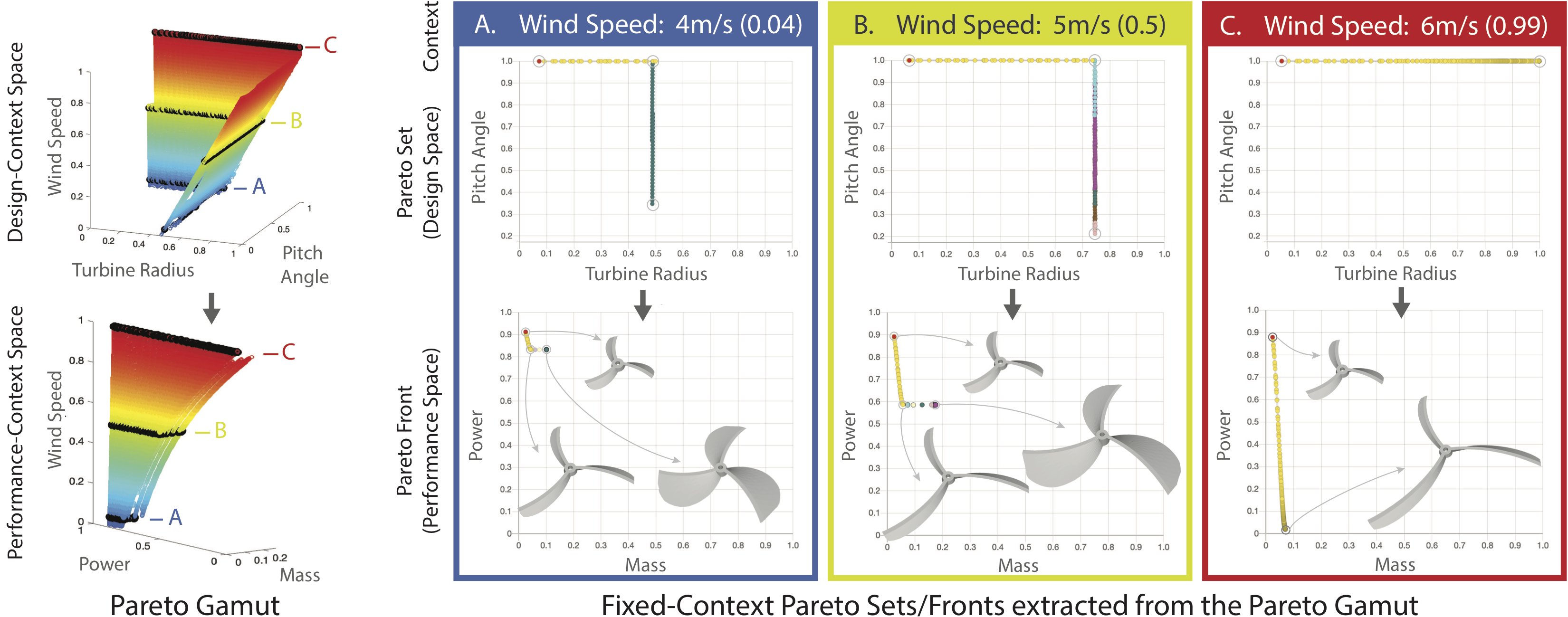Pareto Gamuts: Exploring Optimal Designs Across Varying Contexts
Publication
SIGGRAPH
Authors
Liane Makatura, Minghao Guo, Adriana Schulz, Justin Solomon, and Wojciech Matusik

Abstract
Manufactured parts are meticulously engineered to perform well with respect to several conflicting metrics, like weight, stress, and cost. The best achievable trade-offs reside on the Pareto front, which can be discovered via performance-driven optimization. The objectives that define this Pareto front often incorporate assumptions about the context in which a part will be used, including loading conditions, environmental influences, material properties, or regions that must be preserved to interface with a surrounding assembly. Existing multi-objective optimization tools are only equipped to study one context at a time, so engineers must run independent optimizations for each context of interest. However, engineered parts frequently appear in many contexts: wind turbines must perform well in many wind speeds, and a bracket might be optimized several times with its bolt-holes fixed in different locations on each run. In this paper, we formulate a framework for variable-context multi-objective optimization. We introduce the Pareto gamut, which captures Pareto fronts over a range of contexts. We develop a global/local optimization algorithm to discover the Pareto gamut directly, rather than discovering a single fixed-context “slice” at a time. To validate our method, we adapt existing multi-objective optimization benchmarks to contextual scenarios. We also demonstrate the practical utility of Pareto gamut exploration for several engineering design problems.
Acknowledgement
The authors thank Harrison Wang for his early contributions; Hannes Hergeth for his insights and visualization tool; Paul Zhang, David Palmer, and Ed Chien for their mathematical insights; Tim Erps, Mike Foshey, Andy Spielberg, Beichen Li, and James Minor for engineering examples; and Cartemere for the bike illustration in Fig. 2 and the video. This material is based upon work supported by the National Science Foundation (NSF) (Grant No. IIS-1955697), the NSF Graduate Research Fellowship (Grant No. 1122374), the Intelligence Advanced Research Projects Agency (Grant No. 2019-19020100001), and the Defense Advanced Research Projects Agency (Grant No. FA8750-20-C- 0075). The MIT Geometric Data Processing group acknowledges the generous support of Army Research Office grant W911NF2010168, of Air Force Office of Scientific Research award FA9550-19-1-031, of NSF grant IIS-1838071, from the CSAIL Systems that Learn program, from the MIT–IBM Watson AI Laboratory, from the Toyota–CSAIL Joint Research Center, from a gift from Adobe Systems, from an MIT.nano Immersion Lab/NCSOFT Gaming Program seed grant, and from the Skoltech–MIT Next Generation Program.
Paper
http://paretogamuts.csail.mit.edu/Pareto_Gamuts_Paper_Final.pdf